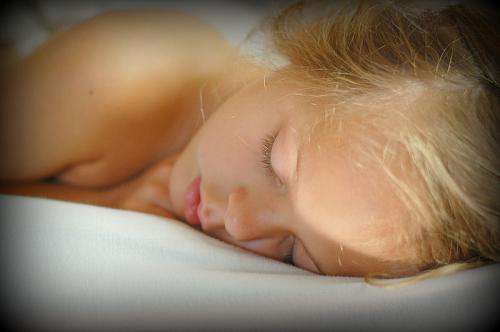Kids likely to sleepwalk if parents have history of nocturnal strolls

More than 60 percent of children developed sleepwalking when both their parents were sleepwalkers in a study among children born in the Canadian province of Quebec, according to an article published online by JAMA Pediatrics.
Sleepwalking is a common childhood sleep disorder that usually disappears during adolescence, although it can persist or appear in adulthood. Sleep terrors are another early childhood sleep disorder often characterized by a scream, intense fear and a prolonged period of inconsolability. The two disorders (also known as parasomnias) share many of the same characteristics and arise mainly from slow-wave sleep, according to background information in the study.
Jacques Montplaisir, M.D., Ph.D., of the Hopital du Sacre-Coeur de Montreal, looked at the prevalence of sleepwalking and sleep terrors during childhood; any link between early sleep terrors and sleepwalking later in childhood; and the degree of association between parental history of sleepwalking and the presence of sleepwalking and sleep terrors in children.
The authors analyzed sleep data from a group of 1,940 children born in the province in 1997 and 1998 and studied in 1999 to 2011. Sleep terrors and sleepwalking were assessed through questionnaires and parental sleepwalking was asked about.
The authors found an overall childhood prevalence of sleep terrors (ages 1½ to 13 years) of 56.2 percent. There was a high prevalence of sleep terrors (34.4 percent) at 1½ years of age but that prevalence decreased to 5.3 percent at age 13.
The overall childhood prevalence of sleepwalking (ages 2½ to 13 years) was 29.1 percent. Sleepwalking was relatively infrequent during the preschool years but the prevalence increased steadily to 13.4 percent by age 10 years.
Study results show that children who had sleep terrors during early childhood (1½ to 3½ years) were more likely to develop sleepwalking later in childhood at age 5 years or older than children who did not experience sleep terrors in early childhood (34.4 percent vs. 21.7 percent).
Children's odds of sleepwalking increased based on the sleepwalking history of their parents. Children with one parent who was a sleepwalker had three times the odds of becoming a sleepwalker compared with children whose parents did not sleepwalk; and children whose parents both had a history of sleepwalking had seven times the odds of becoming a sleepwalker, according to the results.
The study found the prevalence of sleepwalking was: 22.5 percent of children without a parental history of sleepwalking developed sleepwalking; 47.4 percent of children with one parent who was a sleepwalker developed sleepwalking; and 61.5 percent of children developed sleepwalking when both parents were sleepwalkers.
"These findings point to a strong genetic influence on sleepwalking and, to a lesser degree, sleep terrors. This effect may occur through polymorphisms in the genes involved in slow-wave sleep generation or sleep depth. Parents who have been sleepwalkers in the past, particularly in cases where both parents have been sleepwalkers, can expect their children to sleepwalk and thus should prepare adequately," the study concludes.
More information: JAMA Pediatr. Published online May 4, 2015. DOI: 10.1001/jamapediatrics.2015.127














